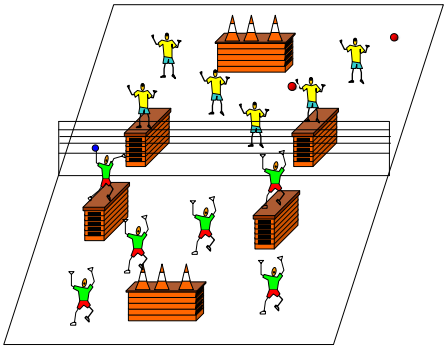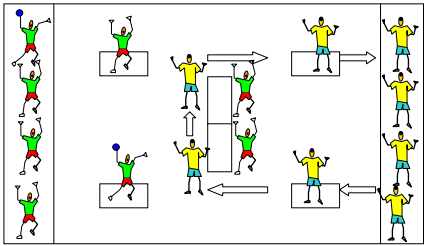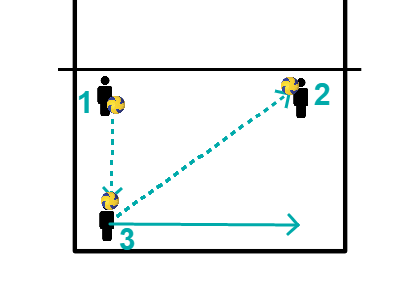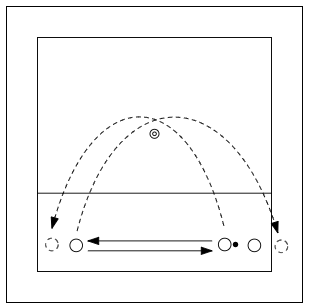Volleyball drills
- The 2 throwers stand on the boxes and the attackers walk on the ground.
- The throwers and attackers try to knock over the pylons or throw off attackers at the opposing team.
Rules:
- You are not allowed to defend your pylons, you can use chalk to make a circle in which the pupils are not allowed to stand.
- As a thrower and as a declarer you can choose to aim at the declarer or at the pylons.
- The defender is not allowed to fend off but if he catches the ball the thrower is out and a new thrower has to come in
- When a player is thrown out, he/she has to sit on the waiting bench, when a pylon of the opposing team is knocked down, all the keepers can go in again.
- Throwers cannot be thrown off.
- When the opponent's pylons have been knocked down, you have won the game, or when all of the opponents' helpers have been removed.

- Divide the group into two teams.
- From both teams 2 children stand on the mats belonging to their team.
- Also 2 children per team stand in front of the cupboard, these are the goalkeepers.
- The children who stay over, go to the throwing square (see drawing).
- When the balls come into play, the children in the box are supposed to throw the balls against the cupboard.

- In pairs with 1 ball and with the net in between.
- On a 3 meter line and serve calmly to each other.
- Throwing up and concentration.
- Same but increase the distance.
- If it goes well then increase the distance again.
- When both players are behind the backline, serve 5 times good.
After that butterfly:
service, reserve, pass, catch
Making an attack run:
- Right handed: left, right, left
- Left handed: right, left, right
- jump with your arms
- Hit with your belly
Pass
- Line up attackers on the outside, pay attention to the run-up and the arms.
- Row of attackers on middle and back
- 3 attackers on position 2, 3, 4 and reserve.
- SV comes in from the back
- in the opposite field 3 blockers on position 2, 3, 4
- at position 6 is a defender
- Trainer throws ball to defender
- defender passes to SV at position 2-3
- SV gives set up at position 2, 3 or 4
- Blockers block and block defence
- attacker gets ball, reserve attacks
- defender changes after 10 good balls
- The players stand in 2 or 3 groups, each with an equal number of players.
- They stand in a row behind each other. The player in front has the ball.
- He passes the ball through his legs and the other players do the same until the ball reaches the last player.
- This last player runs forward with the ball and so the exercise begins again until the whole row is over the line.
Play fanatically in threes. After you play the ball, walk to the other side and connect. Player A plays to player B and connects with player B at the back. Player B plays to player C and connects with player C at the back. Etc.
Next:
- 1 with ball at the net,
- 1 without ball on the backline, flat on belly.
- Attacker hits ball, defender defends on 7meter line,
- Then short ball on 3meter line.
- Dumbbell torso rotation is good exercise for improving core rotational speed.
- First of all, you need to prepare a dumbbell. Initially, you need to hold a dumbbell in the right hand.
- After that, you should touch the ground in front of the left foot. Now, it's time for you to explode from low to high.
- Finally, you'll have the dumbbell above the head on the right side.
Pay attention in the exercises:
- Pass must come high so player can catch the ball 'overhand'.
- Pass to the right, right foot forward
- Pass to the left, left foot forward
- Eyes" of the shoulders in the direction of play
The exercise:
- 3 pairs with 1 ball.
- 1 and 2 stand next to each other, not too close to the net.
- 3 faces 1 in the back of the court.
- 1 throws straight at 3 and 3 passes diagonally to 2.
- 2 catches and throws straight on to 3 and 3 passes diagonally to 1.
- So 3 moves around all the time.

Four exercises are set out, which are completed in time. The teams collect points. After the 4 exercises a mini tournament is played, where all teams play against each other.
- Exercise 1. This is done together. All teams do the same exercise at the same time. Two players lie side by side on their stomachs behind the back line. Number one of the team jumps up and runs to the net. When nr.1 is lying on his belly, nr.2 can leave.
- Exercise 2. No. 1 hits with smash the ball via the ground and the wall to no. 2. No. 1 stands behind a line with two pawns, no. 2 stands on the mat.
- Exercise 3. Nr. 1 serves from behind the 7 meter line, to nr. 2. Nr. 2 passes the ball to himself and plays immediately with an overhand ball the ball over the net to nr. 1. Every good ball that is caught is 1 point. After 2 minutes you can change.
- Exercise 4. No. 1 runs with the ball to the net, from a pylon, passes the ball under the net to No. 2. No. 2 runs with the ball in her hands to her own pilar and back again. Nr.2 then throws the ball over the net to nr.1. Nr.1 runs to her own pilon, and returns to pass the ball under the net. Etc.
Tournament:
- team 1 - team 2 5 minutes
- team 3 - team 4 5 minutes
- team 1 - team 3 5 minutes
- team 2 - team 4 5 minutes
- team 1 - team 4 5 minutes
- team 2 - team 3 5 minutes
followed by possibly a big game.
What you need:
- Exercise 2. mat and 2 pawns, some balls
- Exercise 3. some balls and antenna makes smaller field.
- Exercise 4. single balls and aerial
- 2 teams at the net with 1 ball each
- 1p without ball behind the backline lying flat on belly.
- Attacker hits ball, defender defends on 7 meter line,
- then short ball on 3 meter line.
- The players start by throwing the ball over, close to the net (within 3 m).
- After throwing the ball, each player walks around the pawn at about 5 m and to the other side.
- Variation
- One of the players then decides how the ball will be passed and how the players will move around the pawn.
- The other players imitate this player.

- Stand in pairs by a wall,
- one throws, the other catches.
- If you want to make it more difficult, use a tennis ball







